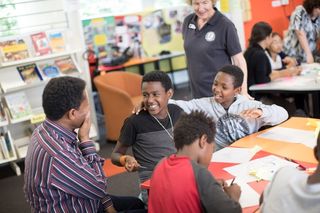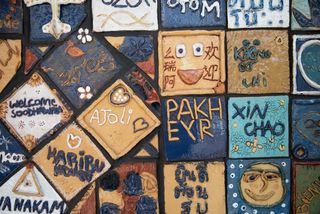Health
Resettling Refugee Children: Building Inclusivity
Children from refugee backgrounds need special programs to foster inclusivity.
Posted December 5, 2018
This post was co-authored by Dr. Sasha Mackay, Research Officer in the Faculties of Health and Creative Industries, Queensland University of Technology. Her expertise lies in oral history and digital storytelling with children and youth.
Humanity in flux
Global health is defined as “an area for study, research, and practice that places a priority on improving health and achieving health equity for all people worldwide." Global health is particularly salient in the context of current migration patterns and, in particular, the impact of forced migration.
According to the latest report by the United Nations High Commissioner for Refugees, there are 68.5 million refugees in the world, 52 percent of whom are under age 18. Australia accepts 20,000 refugees annually.
Our research team has been involved in a series of studies aimed at understanding the experiences of people from refugee backgrounds, including consequences on mental health. More recently, we have focused on children from refugee backgrounds and have worked with a specialized school in Queensland, Australia, which has been established to address the needs of children from refugee and migrant backgrounds. An overarching question of our recent research project was ‘What are the responsibilities of education in the context of an increasingly multicultural society?’
Students of refugee backgrounds resettled in Australia face significant challenges and barriers to achieving the English language, educational success, post-school options, social participation and settlement enjoyed by their Anglo Australian peers. Not only are these students managing a range of stressors – for instance, pre-migration trauma, educational discontinuity, and challenges associated with resettlement in the new country, to name a few — they are often entering an educational system that is under significant resource pressures, impacting schools’ abilities to provide intensive English language learning support and settlement support services.
Our research was motivated in part by school teachers and staff members who highlight the challenges resulting from disengaged children from refugee and migrant backgrounds.
About Milpera State High School
Through a multi-year collaboration with Milpera State High School in Brisbane, our research team at QUT has been investigating the individual factors and systems-level processes that can support the acculturation, settlement and school engagement of students from refugee backgrounds.
Milpera is a specialized school focusing on English-language development and the settlement needs of students from non-English speaking migrant and refugee backgrounds (Our School, Milpera 2018). The school is rich in cultural and linguistic diversity. In 2018, about 200 students aged between 11 and 18 years attended Milpera, representing over 30 countries. This diversity is also reflected among the school staff members, many of whom are bilingual or have also made the journey to Australia from other backgrounds. Students spend between six and 18 months at Milpera where they develop foundational skills enabling them to transition into mainstream Australian schools.

We have been working with Milpera on this and other projects since 2013. One of the most surprising and gratifying findings of our previous research was that children of refugee and migrant backgrounds are doing far better than one might expect in terms of the broader descriptions of the impact of trauma upon children. More specifically, we have reported elsewhere that approximately 80 percent of children in this particular cohort do not evidence difficulties within clinical ranges. Building on these highly positive findings, our recent research project Towards Inclusive Classrooms sought to identify precisely ‘what works’ at this particular school.
School-based factors associated with positive outcomes
For students from refugee and migrant backgrounds, schools are one of the first and most influential service systems after resettlement. School-based programs, processes, and activities can thus play an integral role in students’ overall adjustment to a new environment.

Supporting acculturation and settlement
Supporting students to value their heritage and culture, while simultaneously developing their capacity to understand the values, beliefs, and practices of their country of resettlement is an important process in facilitating settlement. Staff members from Milpera describe the ways dedicated settlement programs, along with whole-school events and activities celebrating cultural diversity, and public acknowledgments of each students’ culture, help students ‘balance’ or ‘merge’ their life from their first country or life in refugee camps with their new life in Australia. In other words, maintaining and continuing to acknowledge a first culture while learning to belong in Australia are equally important components which contribute to students’ overall adjustment.

Fostering socially supportive relationships
Feeling socially included and supported in the school environment promotes students’ general well-being. Developing a sense of connectivity and fostering supportive relationships between all members of a school community – students, parents, and school staff – can protect against the numerous challenges associated with settlement, such as disruption to family networks, insecure housing, and discrimination. School communities don’t necessarily evolve naturally – especially, perhaps, in schools with extremely diverse student cohorts – and so dedicated personnel and programs to support newly-arrived families and students can help create a sense of cohesion, mutual respect, safety, and community.

Belonging
The basic definition of belonging – ‘to be connected with’ – stresses the importance of artifacts and infrastructures in the facilitation of a sense of belonging. The physical environment of Milpera State High School is constructed in a way that encourages students to lay claim to the space, to feel comfortable, and – in the words of school staff and parents – regard it as their “second home." Art and decorations around the school comprise objects from each students’ country and reflect their diverse languages and cultures, enabling them to feel a degree of familiarity, even in a new place.
Conclusions
The resettlement of children in high-income countries poses particular challenges for the children, their families, and the providers of services addressing the needs of a potentially vulnerable group. While our research is at an early stage, the findings do suggest that with effective support and innovative interventions as required, it is feasible to provide a solid foundation for the future development of children who may have experienced extreme adversity.




